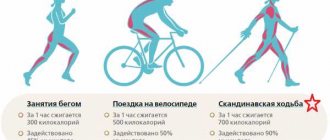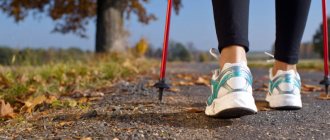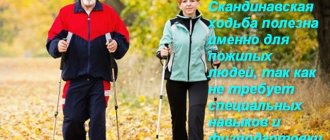The warm season is the best option to start losing the pounds gained in winter. Of course, you can’t do without adjusting your diet, but running will help you become more resilient, tighten your muscles, reduce hunger, speed up your metabolism and, of course, burn fat. Since we spend a lot of energy when running, this creates a calorie deficit - a necessary condition for losing weight. A nice bonus: when running, endorphin is released - a hormone that ensures a good mood.
By the way, during quarantine you can run even in an apartment, but a treadmill is not necessary. And to make your workouts easier and more effective at the same time, use special running apps. With their help, you can keep statistics of workouts (their number, pace, progress, calories burned), create routes, and even compete with other users.
How to start running
If you've never run before, put off your marathon dreams until better times. It is better to start with a short jog, gradually increasing the time and pace so as not to create excessive stress on the muscles and cardiovascular system. Perhaps the ideal way to start your running training is to walk briskly.
Usually, beginners are frightened by the sensations after running: increased heart rate, irregular breathing rhythm, and a tingling sensation in the side. This is how the body tries to adapt to new conditions. You shouldn’t quit right away - it will become easier after time, of course, if you have chosen a pace that is not too fast for you. They define it this way: while running, you should talk calmly. You can also focus on the pulse rate - the easiest way to calculate it is by the percentage of the maximum pulse rate of the MCT - “220 minus age”. That is, a safe heart rate for a 35-year-old person will be 185 beats per minute.
Professional trainers recommend joining the ranks of runners using the interval method.
- First week: Run for 3 minutes at a fairly fast (not speed!) pace. Then go to a quick step for 2 minutes. You need to do about 6 such repetitions.
- Second week: increase your running time by 1 minute - do 5 repetitions.
- Third week: run for 5 minutes (4-5 episodes). Walk for 2 minutes.
- Week four: Reduce walking time to 1 minute (4-5 series).
- Week 5: Run for 30 minutes without a break.
- Add 5 minutes each week.
If it gets tough, go back to the previous week. And, of course, don’t forget about warming up before running to warm up your muscles, and stretching after to relieve tension.
Main types of running injuries
- Sprains. Localized in the hamstrings or Achilles tendons, as well as the tendon of the tibialis posterior muscle.
- Tear. Occurs in the meniscus of the knee joint or the quadriceps femoris muscle.
- Inflammation. Occurs in the plantar fascia, kneecap or Achilles tendon.
Foot injuries:
- Inflammatory process in the sole. Manifests itself in pain on the inside of the heel. Occurs due to running in shoes not designed for this purpose. If the edges of the feet begin to hurt, it means the athlete is placing his feet incorrectly while jogging. And after running on hard surfaces, sometimes the discomfort when standing up increases.
- Inflammatory process in the Achilles tendon. Due to the low flexibility of the muscle tissue in the calf area, heel pain occurs when walking. If the heel is swollen, then the problem is due to racing while running without warming up. The temperature of the skin may increase due to fatigue due to increased load. Sometimes there are spasms in the muscles of the calves, which is due to the uneven surface on the route.
- Achilles tendon sprain. It manifests itself in acute pain in the ankle when running without warming up. The feet swell due to jerking movements. Discomfort when putting weight on the toes and clicking when flexing the arch of the foot indicate incorrect foot placement.
- Dislocation of the ankle joint. If you turn your foot sharply, a sharp pain occurs. Swelling occurs from falling to the ground. If the leg begins to ache when putting weight on it, then the dislocation occurs due to improper placement of the foot. This also manifests itself in the formation of a bruise.
When is the best time to run?
There are morning, afternoon and evening runs. For weight loss, there is no fundamental difference in choosing the time of day. Focus only on your body.
It is believed that morning jogging gives a good supply of energy for the whole day. However, after sleep, the body needs more energy to warm up. Therefore, after waking up, at least half an hour should pass before jogging. Usually, morning jogging on an empty stomach is recommended for weight loss, since a calorie deficit will start the fat burning process. But if you have no strength at all, you can drink a glass of warm water with half a teaspoon of honey - fast carbohydrates will provide the necessary energy.
During the day, our muscles are more or less warmed up, therefore, we will have more energy for running. Just remember that your last meal should be no later than 1.5 hours before training. And it’s not too voluminous. It is believed that daytime running is the best way to strengthen muscles.
Evening time is optimal to relax after a hard day of work. And a workout done a couple of hours before bedtime will help burn fat at night (just don’t have dinner after an evening workout. Otherwise, all your efforts will be in vain. If you really can’t bear it, drink a glass of kefir).
Safety instructions for athletics lessons
INSTRUCTION No. 1
on safety measures for students
during athletics
I. General safety requirements.
Classes are conducted only with working sports equipment and equipment.
The training location must be equipped with fire extinguishing equipment (fire extinguishers, etc.) and have a first aid kit equipped with the necessary medications and dressings to provide first aid to victims.
On the subject: What is healthier: a treadmill or an exercise bike?
Students are allowed to take classes:
- those classified for health reasons in the main and preparatory medical groups
— have undergone safety training
- having sports shoes and a uniform that does not restrict movement and corresponds to the topic and conditions of the classes
The student must:
- start the lesson, take sports equipment and perform exercises with the permission of the teacher
- treat sports equipment and equipment with care, do not use it for other purposes
- listen carefully to the explanation of the order and technique of performing the exercises and remember them
- start doing exercises at the teacher’s signal
- know and follow these instructions
— if this instruction is not followed, undergo an unscheduled briefing
For failure to comply with security measures, a student may not be allowed or suspended from participating in the educational process.
II. Safety requirements before starting the lesson.
The student must:
- change clothes in the locker room, put on sports uniform and shoes
- remove items that pose a danger to other participants (earrings, watches, bracelets, etc.)
- remove sharp and other foreign objects from the pockets of the sports uniform
- under the guidance of the teacher, prepare the supplies and equipment necessary to conduct the lesson
- go to the lesson location with the permission of the teacher
- at the teacher’s command, get into formation for a general formation
III. Safety requirements during the lesson.
RUN
The student must:
- in a group start for short distances, run only along your own track, which must continue for at least 15m beyond the finish mark
- while running, look only at your path
- to avoid collisions, avoid stopping abruptly
- return to the start along the outermost path; When starting at a distance, do not put down steps, do not delay your opponents with your hands
- in long-distance running, overtake those running on the right side
- when running over rough terrain, complete the task along the track or route designated by the teacher
- perform a warm-up run on the outermost track
JUMPING
The jumping pit should be filled with sand to a depth of 20-40cm. Before jumping, it is necessary to thoroughly loosen the sand in the jumping pit, remove rakes, shovels and other foreign objects from it.
Important!
The jumping technique must comply with the curriculum and ensure that the student lands on his feet.
The student must:
- place the rake with the teeth down
- do not perform jumps on uneven, loose and slippery ground, do not land when jumping on your hands
- perform jumps when the teacher has given permission and there is no one in the pit
- perform jumps one at a time, do not cross the runway while another student is performing an attempt
- after completing the jump, quickly vacate the jumping pit and return to your place for the next attempt on the right or left side of the runway
Throwing
You need to be careful when practicing throwing.
The student must:
- before performing throwing exercises, see if there are people in the throwing sector
- do not leave sports equipment unattended
IV. Safety requirements in case of accidents and extreme situations.
The student must:
- if you are injured or feel unwell, stop classes and notify your physical education teacher
- with the help of the teacher, provide first aid to the injured person, if necessary, take him to the hospital or call an ambulance
- if a fire occurs, immediately stop the lesson, in an organized manner, under the guidance of the teacher, leave the place of the lesson through emergency exits in accordance with the evacuation plan
- by order of the teacher, notify the administration of the gymnasium and report the fire to the fire department
V. Safety requirements at the end of the lesson.
The student must:
- under the guidance of the teacher, remove sports equipment
- leave the lesson location in an orderly manner
- change clothes in the locker room, take off your tracksuit and sports shoes
- wash your hands with soap
Source: https://xn--j1ahfl.xn--p1ai/library/instruktazh_po_tehnike_bezopasnosti_na_urokah_lyogko_104905.html
How long should you run to lose weight?
Our body is designed in such a way that during cardio exercise, it runs on carbohydrates for the first 40 minutes of running and only then begins to burn fat. But to reach such a time, for beginners it will take at least three months. Therefore, do not forget to eat right, exercise at least three times a week, and best of all daily with one or two days off per week. And also alternate between different types of running - intervals (running - fast walking), jogging, cross-country, cross-country, etc.
You can also try to master the jogging technique, at which the speed is 6-9 km/h, that is, not much higher than that of a pedestrian. Unlike interval running, the trainee runs continuously at a leisurely pace for 40-50 minutes.
Knee injuries while running:
- "Runner's Knee" Appears due to irritation of the surfaces of the kneecap and cartilage. Manifestations include pain and stiffness in this area. In addition, the situation is aggravated during squats and lifts. There are several reasons for the occurrence - it could be flat feet, insufficient training of the quadriceps femoris muscle, or infrequent knee flexion.
- Knee meniscus tear. The cartilage layer of the knee is damaged, which is expressed in acute pain, swelling of the knee, and weakened motor abilities. If you turn sharply or place your foot incorrectly, a meniscus tear occurs.
- Arthrosis of the knee joint. It is a complication of a tear. Therefore, it is so important to quickly seek medical help and quickly make an accurate diagnosis.
Contraindications to running for weight loss
Of course, before you start exercising, it is best to consult your doctor. So, being overweight can be a contraindication for running (in this case, just start walking more). Running is also not recommended for those who suffer from heart disease, bronchial asthma, or hypertension. People who have stage two or higher varicose veins are not recommended to run a lot. And, of course, it is worth stopping training for a while for those who have recently had abdominal surgery or leg injuries.
BY THE WAY
— Assess your physical fitness
Running a marathon sounds nice, with a hint of heroism. Without which, let’s face it, the participants of such a competition cannot do without it – it’s just not possible to run 42 kilometers. It is believed that a half marathon requires active training for 2-3 months, and a marathon - for at least 4. This is a big load for the body, so both the volume of training and the distances you cover must be increased gradually.
But don't get too carried away
, especially if there are a couple of weeks left before the competition.
During this period, on the contrary, you need to reduce the intensity of your training, otherwise by the day of the race your body will be exhausted. While training, monitor your well-being
- malaise and pain cannot be left unattended, as in the future they can “grow” into injury.
Ideally, overcoming long distances like half marathons and marathons should be a logical continuation of a long passion for running and regular training. This is what can give a runner proper physical preparation.
“People who decide to increase their endurance need to adhere to a certain regime - in particular, regularly train,” says Elena Govorova, Herbalife fitness expert, Olympic bronze medalist in the triple jump. — It is important to recover after classes.
The isotonic protein-carbohydrate drink “Increasing Endurance” HERBALIFE24 copes best with this task. This drink provides energy to effectively continue your workout, provides protein and restores water-salt balance. And also eat a balanced diet - the result of your work in training largely depends on what kind of diet you have.”
Running in place
During the cold season or during quarantine, we can replace jogging outside with jogging on the spot in the apartment. And yes, sneakers for this type of running are also required - so as not to injure your feet and knees.
You can alternate between different running styles and paces. For example, simple, without jumping - when you move, as in normal jogging. Running with high knees, or running with shin sweeps, or if there is enough space, shuttle running. By alternating different types of load, you will avoid monotony and give load to different muscle groups.
ADVICE
If you decide to break quarantine and run in the fresh air, choose deserted parks or paths. And don’t wear a mask - it makes breathing difficult, which means you will lose your rhythm.
Preventing running injuries
It is better to prevent a disease than to treat it. Therefore, experts advise following a number of rules:
- Do a warm-up. It is best to carry out exercises to develop flexibility, jumping on each leg and others.
- Compliance with running techniques. To avoid injury, you need to land on your entire foot or just your heel, and then roll onto your toes.
- Concentrate on jogging, do not be distracted by extraneous factors, such as music or a telephone conversation.
- Avoid complete exhaustion of the body. Most injuries occur during the last leg of a run.
- Reduce the intensity of exercise for people who are overweight.
- For beginners, choose a specific type of surface and practice on it, for example, synthetic, natural or slippery surfaces. The fact is that each of them has its own technique.
- Avoid jogging after severe emotional upheaval and only run in a good mood.
- Find a suitable company in our community so that, if necessary, a companion can provide first aid.











